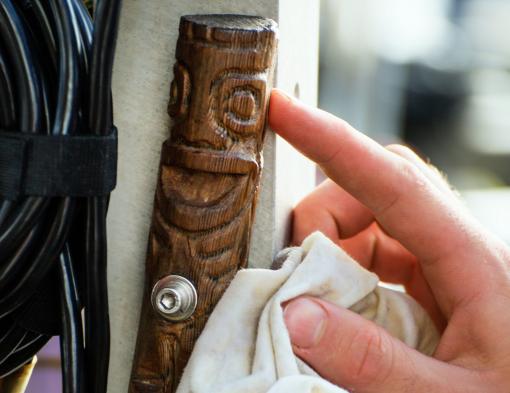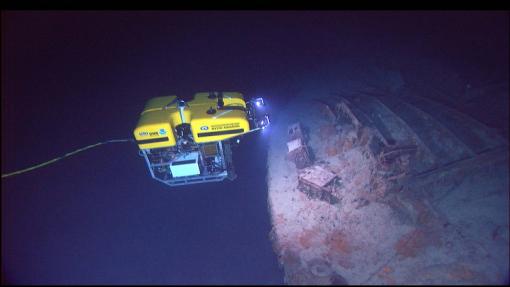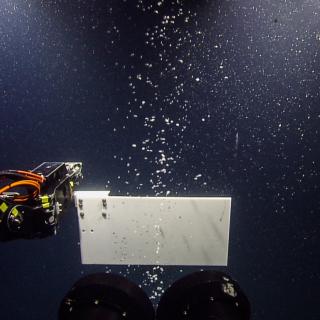Journey to Titanic: ROV Hercules & the "Oiling the Tiki" Tradition

Today marks the 30th anniversary of the discovery of the RMS Titanic by our President and Founder, ocean explorer Dr. Robert Ballard. It isn't widely known that both the ROV Hercules and the ROV Argus on board E/V Nautilus have explored the wreck of the Titanic, most notably during the 2004 expedition with National Geographic to survey the condition of the wreck site.
Operations on E/V Nautilus would not be possible without the expertise of our highly experienced engineers and crew. At sea an equipment failure could compromise an entire cruise, or even a whole season, depending on the instrument. When an instrument breaks fixing it is much more challenging than simply running over to the local hardware store. Even with perfectly tuned equipment, rough seas or stormy weather could mean serious delays for a dive plan. E/V Nautilus and its ROVs have had their fair share of challenges. With each challenge, we have grown stronger as a team and learned how to better prepare for the future.
In 2004 while diving on the wreck of the Titanic, both vehicles were launching from the NOAA research vessel Ronald H. Brown to conduct mapping and visual surveys of the wreckage 12,500 feet below. During the first dive, the team encountered numerous issues and failures with Hercules. The Chief Bosun on the Ronald H. Brown, Bruce Cowden, is a woodworker and artist who has illustrated two "Teacher at Sea" children's books for NOAA Publications, and he had the idea to carve two "Tiki" idols for the vehicles for good luck (a seafaring tradition). He used driftwood he recovered during a former cruise and his skills were well known among the crew as he carved numerous necklaces and trinkets for the science party during 2004-2005 expeditions.

He carved the Tiki for Hercules first. Decidedly male, it was installed on the main metal frame of the ROV. As the principle mechanical designer of Hercules and ocean engineer Todd Gregory recalls, "All problems with Hercules went away when we installed the Tiki. This was likely coincidental, as typically the first few dives of season tend to shake bugs out of the system, but that didn't matter to the team at the time."
Argus' Tiki was created shortly thereafter (though not installed during the same dive), and was designed to be the female counterpart to Hercules' Tiki. However, when the crew installed Argus' female Tiki, a few problems arose, so they promptly removed it.
"It must have worked," recalls ocean engineer and ROV pilot Brennan Phillips. "There was one particular dive toward the end of our expedition that I'll never forget. After days of challenging operations and a few failed dives, we were trying to coordinate placing the vehicles over the bow of Titanic during a live broadcast from the ship. I remember Todd Gregory driving Hercules into the right position with less than a minute to spare, and it seemed like all of the stars had aligned at that point."

Ever since then the Tiki has been on the ROV Hercules as a good luck charm and before each dive we apply oil to the Tiki for good luck, with the honor usually falling to one of our ocean engineering interns on the ROV team.
The challenges of exploring the ocean are numerous. Storms and squalls can appear seemingly out of thin air while out at sea, and visibility underwater can become nonexistent in a moment. Our expedition leaders must pay close attention to multiple weather forecasts while planning dives and making the decision to recover the ROV's. Typically, the team avoids putting in the ROV's in the water if winds and currents are above 15 knots or if swells are over 3 meters due to the tension they would place on the fiber optic tether connecting the ROV Argus to the ship. In the best case scenario, our expedition leaders are able to cancel or postpone a dive before the seas reach these conditions, but sometimes the situation can change suddenly while the vehicles are in the water. In these situations, the ROV team and the expedition leader must decide whether to risk an emergency recovery or to wait out the storm with the vehicles in the water.
But before every dive, just to be safe, we apply some oil to the Tiki, just in case it helps.

Lightning strikes in the distance during a night recovery of the ROVs Hercules and Argus from the E/V Nautilus. Photograph by Susan Poulton
This story was told by Todd Gregory and Brennan Phillips. Todd Gregory was the principle mechanical designer of the ROV Hercules, which he continues to refine for use as a remote tool for ocean exploration and archeological oceanography. He continues to work with the Nautilus crew as an ROV pilot and ocean engineer.
Brennan Phillips is a Ph.D student in Biological Oceanography at the University of Rhode Island, and is also an oceanographic engineer with extensive offshore experience working with both ROV's and AUV's. He can often be heard on our live video stream as the pilot of the ROV Hercules and Brennan has been working for Dr. Ballard since 2004 and has participated in many expeditions aboard E/V Nautilus.

GISR: Natural Gas Seeps in Gulf of Mexico
What impact do natural hydrocarbon seeps have on the ocean and atmosphere? This is one of the key questions we’ll be investigating on this leg of the expedition. This expedition is part of the Gulf Integrated Spill Response (GISR) Consortium, funded by the Gulf of Mexico Research Initiative (GoMRI). The vision of the GISR Consortium is to understand and predict the fundamental behavior of petroleum fluids in the ocean environment.



